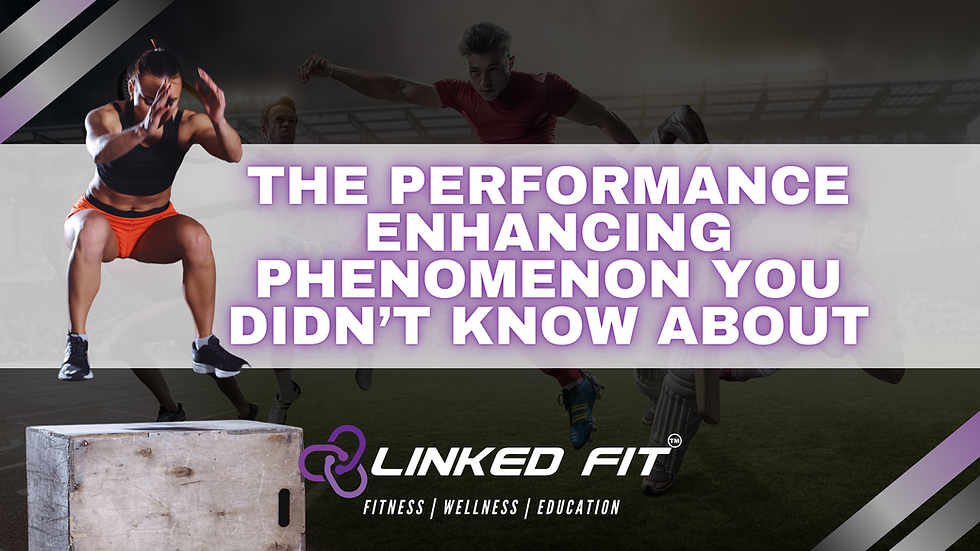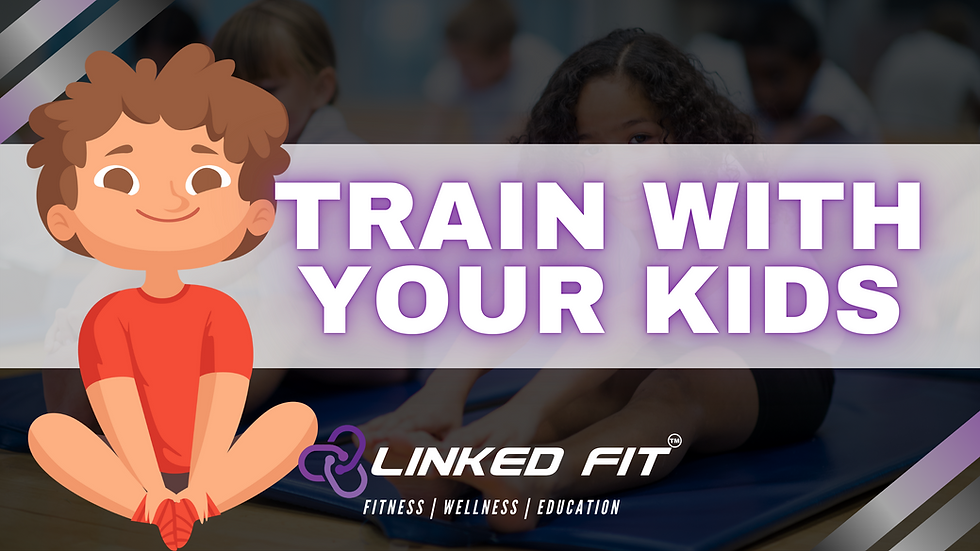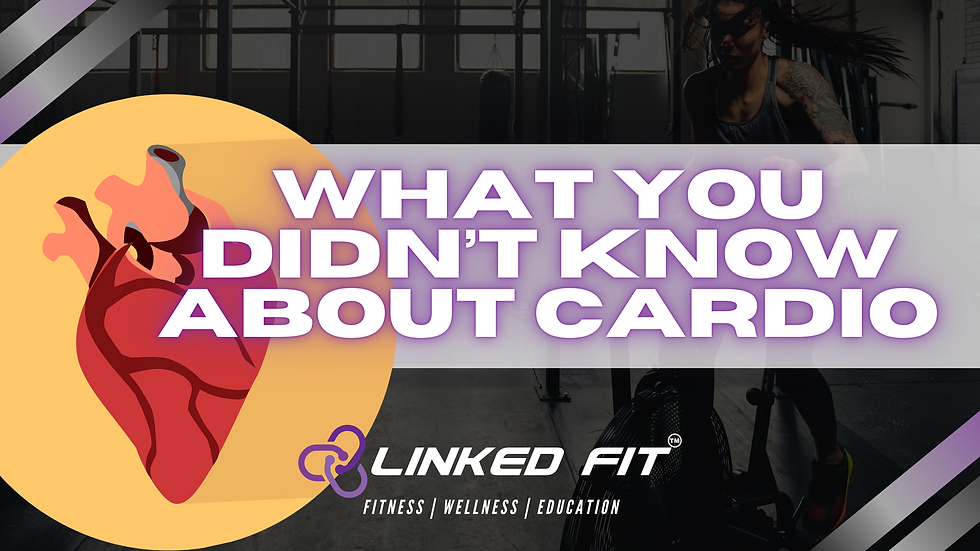Screen. Assess. Test.
- Linked Fit

- Aug 31, 2018
- 9 min read
Updated: Jan 2, 2022

Every client should begin a journey with a proper evaluation. For most clients, an evaluation is the beginning of their journey. The components included in an evaluation will allow for continual monitoring of needs, functional capabilities, physiological and psychological effects of exercise. It will also help build a rapport, and provide an individualized approach when a fitness professional is designing their program. A systematic plan should be in order so nothing is overlooked. Incorporating this system will determine the client's or athlete's goals, needs, and abilities.
At Linked Fit HQ, we take pride in all of our evaluation procedures. Administering an evaluation with a client should be a priority, otherwise, it just turns into a guessing game while coaching the client. A coach should prioritize their evaluation, to prioritize their coaching. Each component is carefully thought about so the correct objectives are planned. This article will discuss the LF evaluation system and how they are structured.

Determine the Population
First things first, it's important to determine the population that will be evaluated. In previous or current communication with the prospect, what is their likely classification (list below)? This will help a fitness professional think ahead and produce a pre-evaluation plan. Of course, as with any evaluation, a fitness professional's plan can be modified as further data is collected. Modifications are acceptable since each individual holds their own personal abilities and limitations. Depending on the population different components will be added and others will be taken away. Remember, a coach should be client-centered so they can deliver the BEST outcome for the client. Learn more about being the best coach with this article by Dr. Bartz (Article: Become the BEST Coach!).
Below are a few populations that Linked Fit works with on daily basis via their facility, outreach, or online services.
Athletic Population:
Athletes are a part of a sport, which can be team-based or solo participation. The athlete can be classified as elite, sub-elite, or amateur. There are a variety of sports that can be considered, such as basketball, football, Olympic weightlifting, snowboarding, tennis, downhill skiing, and more. A coach's goal should be to enhance their athletic potential in their respected sport.
General Population:
General population clients are in it for the lifestyle! Their individual goals tend to include increasing strength, lean muscle mass, quality of life, and other physiological/psychological qualities. Also, decrease body fat percentage, body weight, blood pressure, and stress levels. General population clients typically have goals of increasing fitness capacities and wellness habits as well.
Special Population:
Special population clients are likely to have movement limitations which can result in pain or discomforts. These individuals may have been discharged from physical therapy or recommended by a physician. Also, these types of clients may be experiencing life alterations from illnesses, diseases, or cancer that significantly impact their limitations. A coach's responsibilities should include improving the client's functionality and enhancing their quality of life by means of fitness and wellness habits.
Tactical Population:
Tactical facilitators use their minds and bodies to serve and protect individuals, communities, states, countries, and themselves from various threats. These individuals may be the first to respond and assist in emergencies, accidents, natural disasters, and terrorist attacks. These individuals include special weapons and tactics (SWAT), special operation forces, military, law enforcement, and firefighters. A coach should plan on enhancing these clients' tactical skills but also improve their physiological and psychological ramifications from the high-exposure occupation.
Youth Population:
This population is currently in the stages of growth and development. Depending on what stage of life they are in, it is ideal to design a different style program that will meet their needs. Therefore, at this age, make training fun and enjoyable! However, including formats of long-term athletic development so these types of clients continue the path of a healthy and active lifestyle.

Questionnaire
Secondly, a questionnaire will be integrated to gather data on the individual's fitness and wellness habits. Questions will help build a profile of the client, which will be used as a base for the upcoming step of the evaluation. The questionnaire includes subjective information that focuses on occupation or sport, training status, training background, movement experience, previous injuries, health and medical history, and goals. Different questionnaires can be utilized depending on the population to better fit the individual potential needs.
As mentioned earlier, adjustments may be needed as you continue to work with the client. At Linked Fit, we encourage coaches to send out a questionnaire before the consultation so a minor profile can be reviewed beforehand. Below are some example questions that we utilized in our coaching questionnaire.
Fitness Questions:
How many years of training experience do you have?
If you are experienced in training, please explain what you have experienced in the past?
Have you struggled with any particular movements?
Are there any movements that are painful?
What fitness habits are looking to improve?
Wellness Questions:
How many hours of sleep do you get?
What would you rate your eating habits?
What is your average stress level throughout the day?
What is your highest stress level in the week?
How do you typically restore the body after a stressful situation?
Consultation
In the third step, a consultation will be scheduled to evaluate the client face-to-face or virtually, if working with an online client. At this point, a fitness professional can really dive into the information collected in the questionnaire. It is important to understand the individual's strengths and struggles so they can be considered when designing an optimal program. Reiterating questions to gather more information can be helpful in determining the action plan. If a coach needs more information or other questions come up, this is a perfect time to consult with the client about it.
Fitness professionals should examine the client's goals to make sure they are specific, measurable, achievable, realistic, and timely (SMART). Developing SMART goals can be a tricky task for coaches, but remember, a coach needs to be the expert in the room and may need to guide the client through the development of their goals. At Linked Fit, we always develop two goals: short-term and long-term goals. To learn more about SMART goals, read this article by Dr. Bartz (Article: Behavioral Change).

The consultation can also include physiological assessments such as resting heart rate (not true resting heart rate), blood pressure, body composition, body fat measurements, body circumference, and body mass index (BMI). As a coach, we encourage all coaches to take note of the client's static postures during the consultation. This is a great time to assess the natural positions of the head, cervical spine, scapulas, and more while sitting or standing. Lastly, it is ideal for coaches to build a rapport with their new clients and recognize the client's reasonings for their new goals. This will help guide their journey and motivate them along the way!
Screen
After the consultation, a movement screen should be administered to evaluate the client's dynamic movement functionally. At Linked Fit, we aim to get a baseline reading of the individual's movement quality while under no direct load (external weights). A foundational movement screen is included in the LF Assessment. At LF, our coaches rate the screen in a simple YES or NO rating (sometimes we utilize a 0 to 3 rating). Our goal is to review a movement and understand if a client's competency of the movement is good enough to move on or if it needs attention in their programming.
These foundational movements are critical in programming and reviewing the movements beforehand will help the coach understand the client's starting point. Remember, not all clients should start off with a barbell movement or highly skilled dynamic movements. Inform the client that movements are earned in the pyramid. This is critical in the process of injury prevention and movement competency.
Foundational Movement Screen:
Squat
Hinge
Lunge
Pull
Push & Pillar Stability
Gait
During the movement screen, coaches have the ability to capture transitional and dynamic posture. AKA, posture during movement! Since posture is a dynamic quality, observing postural distortion and dysfunctional movement patterns will help identify concerns within a client's potential stability, mobility, and/or extensibility. Very similar to the static postural assessment, transitional or dynamic postural assessments look at the feet, knees, lumbopelvic hip complex, shoulders, and head. A variety of movements used during a screen should assess dynamic flexibility, mobility, core strength, balance, and motor control.
Assess
Following a movement screen, a movement assessment may be administered to gather further objective information from the client's movement qualities and quantities. A movement assessment does not need to be administered for each individual. Typically, these assessments have a particular joint focus and are aimed to address a client's individual needs. If a client was rated NO or scored low on a particular movement screen, further assessments will be needed to determine the hidden issue. This is the time to introduce Selective Movements, which is a unique assessment protocol to isolate pain-provoking movement patterns and dysfunctional patterns. Or, in other specifics, the differences at the joint between mobile or stable classifications. At Linked Fit, our coaches use Selective Movements not to assess pain but provide a clearer understanding of extensibility, mobility, and stability dysfunctions. These limitations help guide programming for a move individualized approach.
At this time, range of motion (ROM) might be useful. Joints have an optimal range of motion and this type of assessment will help identify proper and altered motions and muscular lengths. The use of ROM is known to correlate with movement dysfunctions which can help develop an optimal preparation, training program, and restorative strategies. Other assessment procedures can be utilized such as manual muscle testing. Manual muscle testing can be used to help determine if a muscle or function is weak or strong. These muscular functions allow a fitness professional to address patterns of compensation. Including movement assessments that are specific in nature can help select appropriate exercises to develop muscular imbalances and joint dysfunctions. Below is a list of the degrees of ROM for joints.
Normal Joint End Ranges of Motion:
Shoulder
Flexion = 160 degrees
Extension - 50 degrees
Abduction - 180 degrees
Internal Rotation = 45 degrees
External Rotation = 90 degrees
Hips
Flexion = 120 degrees
Extension = 0 to 10 degrees
Abduction = 40 degrees
Adduction = 15 degrees
Internal Rotation = 45 degrees
External Rotation = 45 degrees
Knee
Flexion = 140 degrees
Ankle
Plantarflexion = 45 degrees
Dosriflexion = 20 degrees
Test
Lastly, performance testing can be administered to examine the client's fitness and athletic abilities. A variety of testing can be utilized from power, strength, endurance, and sports-specific movement skills. In the strength and conditioning world, this is where we live! It's the fun stuff! These tests will help coaches develop a program that aims to improve their goals and needs. The data will collect at this point will be used for future comparison. A coach shouldn't collect data and then never revisit or use it again. Time is precious and shouldn't be wasted!
When planning performance tests, be sure to incorporate tests that are relative to the individual's goals or needs. In athletic performance, administer tests that relate to the biomechanics and energy demands of their sport. A coach shouldn't administer random tests that do not provide any transition to the client or athlete. Perform tests that will establish a positive foundation and performance. As mentioned a moment again, don't waste time on collecting data that shouldn't be collected. If there is a reason for the test and a coach plans on using it for future comparison, then note it in your plan for actionable consideration.
Below are a few tests that are utilized in the world of coaching. The world of technology has greatly impacted this area of coaching. A variety of tools can be used to evaluate a client nowadays. However, in most cases, this technology comes with a high price but if a coach utilizes it on a regular basis, it's likely worth the purchase.
Performance Testing
Vertical Jump
Bench Press (1RM, 3RM, or 10RM)
Olympic Lifts (snatch, clean, or hang power snatch)
Back Squat
Mid-Thigh Pull
Power Measures
Velocity
T-Test
Non-Countermovement Jump
Countermovement Jump
Medicine Ball Throw
Sprints
VO2 Max Testing

After all of the components have been completed, developing the plan of action is next. Selecting optimal exercises, training frequency, order, intensity, repetitions, volume, habit building, and rest periods should be applied to produce a well-designed program. A cookie-cutter approach should not be used while designing a program. Each individual will hold a unique set of strengths and struggles which should be addressed in the program. Individuals are investing in your programming to help them increase strength, lose weight, and/or perform better on the athletic field/court, so with that being said, address each program with care.
It's important to schedule re-evaluations in a timely fashion, which can be every 3-months, 6-months, or year. The re-evaluations schedule can depend on your system structure and how you plan to organize your clients. It is plain and simple, clients love to see progress! I mean, who doesn’t like to see the data getting better and improving numbers! If the re-evaluation doesn’t provide prosperity, appropriate actions should be taken by addressing the weak links. This re-evaluation might include only a few things covered throughout the process. It will likely not include the entire evaluation as before, but likely include a few movement assessments that needed attention or testing that endorsed the power of the programming KPI's.
Overall, I hope everyone enjoyed reading this article. Although it did not provide all components that can be covered in the complete mapping of our evaluations at LF, I aimed to include the tools that are feasible for coaches to build their own road map. Continue to learn and expand your horizon with other professional education opportunities. These learnings will increase your toolbox size and upgrade your approaches for your client's outcomes.
References:
Alvar, B A, Sell, K, & Deuster, P A. NSCA’s essentials of tactical strength and conditioning. Champaign, IL: Human Kinetics; 2017.
Baechle, T R, & Earle, R W. Essentials of strength training and conditioning: National strength and conditioning association, 3rd edition. Champaign, IL: Human Kinetics; 2008.
Clark, M A, Lucett, S C, & Sutton, B G. NASM essentials of corrective exercise training. Burlington, MA: Jones & Bartlett Learning; 2014.
Clark, M A, Lucett, S C, & Sutton, B G. NASM essentials of sports performance training. Burlington, MA: Jones & Bartlett Learning; 2015.
Cook, G, Burton, L, Kiesel, K, Rose, G, & Bryant, M F. Movement: functional movement systems. Santa Cruz, CA: On Target Publications; 2010.
Thompson, W R, Bushman, B A, Desch, J, Kravitz, L. ACSM’s resources for the personal trainer, 3rd edition. Baltimore, MD: Lippincott Williams & Wilkins; 2010.
Weinstock, David. NeuroKinetic therapy: an innovative approach to manual muscle testing. Berkeley, CA: North Atlantic Books; 2010.




Comments